Phirni also called as firni is a classic slow-cooked Indian sweet pudding made with basmati rice, milk, nuts, sugar and scented with cardamom powder or saffron or rose water. It is a must in North India on festive occasions or special celebrations like Diwali as well as for Karwa Chauth Festival. Try my classic and traditional Phirni recipe with step-by-step photos and video. I am sure it will become your new favorite Indian sweet.
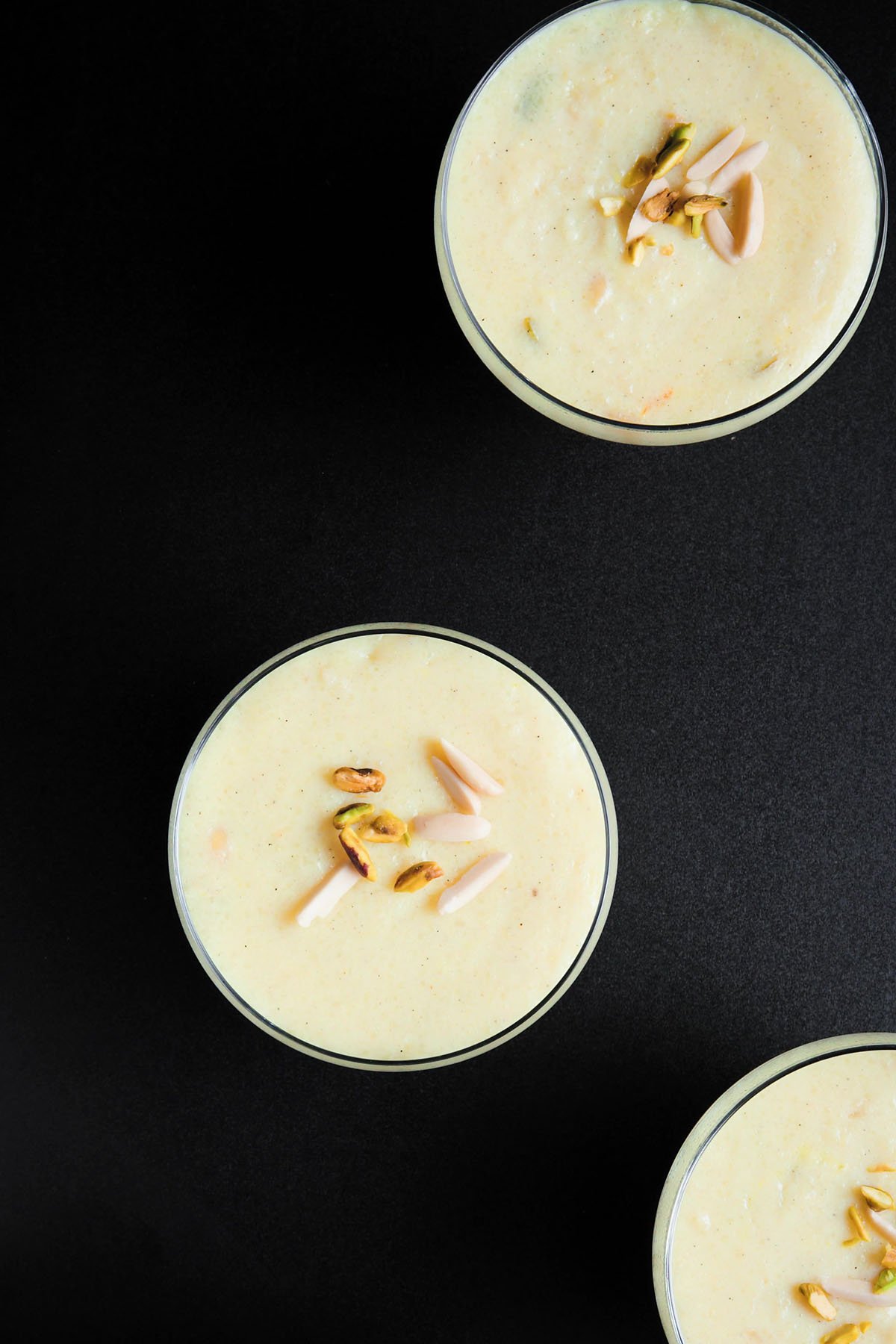
What is Phirni
Phirni is a thick and creamy pudding made from ground rice. To make the simplest and yet the best phirni recipe all you need is rice, milk, sugar, nuts and flavorings of your choice like saffron or cardamom powder or rose water.
Slow cooking is the key to make a perfect phirni. The ground rice granules are slow-cooked in milk to a creamy and thick consistency.
Phirni has a lovely aroma from the basmati rice and using aromatic ingredients like saffron, rose water or cardamom powder. Adding nuts like almonds or pistachios make it more rich and flavorful.
Table of Contents
Firni is traditionally served in small earthen bowls called shikoras or matka. These earthen bowls absorb the extra moisture and liquids and make it more thicker.
They also infuse the rice pudding with an earthy aroma. So if you want to make matka phirni then pour the cooked phirni in matka or shikoras. Cover with a lid or aluminium foil and refrigerate for few hours.
It is a much loved North Indian sweet pudding besides Rice Kheer, Vermicelli Kheer and Sheer Khurma.
Difference between Phirni & Rice Kheer
While at the looks of it, though both phirni and rice kheer look similar, they are actually made differently. Phirni is made from ground rice, while Rice Kheer is made from whole rice grains.
A good quality basmati rice is the preferred rice to make both firni as well as rice kheer. While making phirni recipe it is important to grind the rice well.
The addition of saffron strands or rose petals adds a nice flavor and aroma to the dish. Phirni is always eaten chilled whereas rice kheer can be had warm or cold.
Both phirni and rice kheer are my family favorites and I often end up making these on festive occasions.
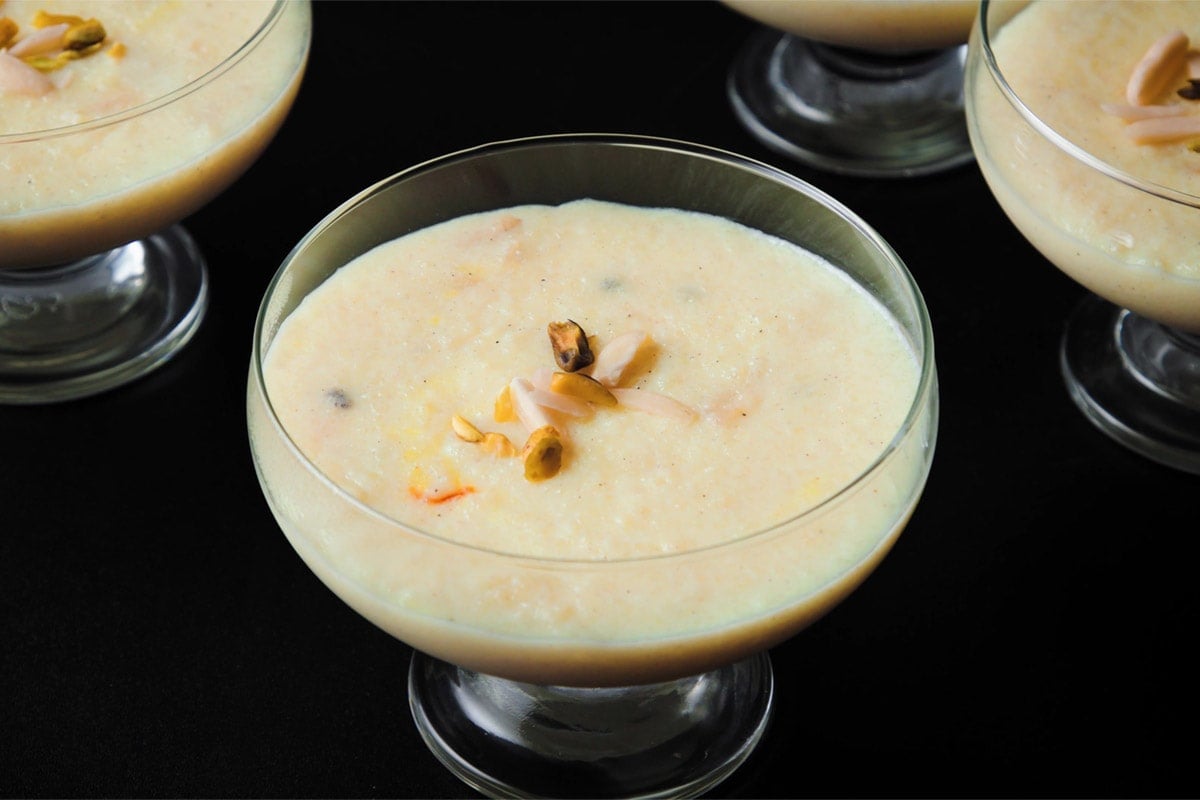
How to make Phirni Recipe
1. Rinse ¼ cup basmati rice a couple of times in water.
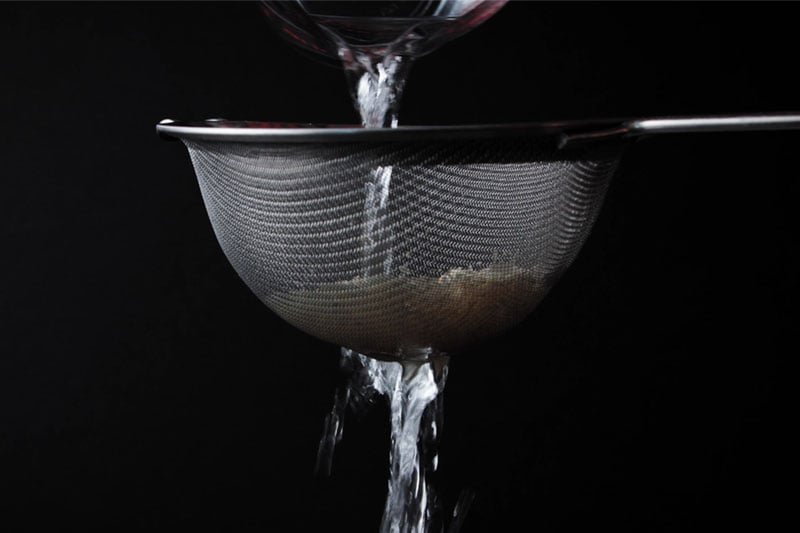
2. Drain the water very well and let the rice grains dry on their own by spreading them on a tray/plate or you can even wipe the grains dry with a kitchen towel.
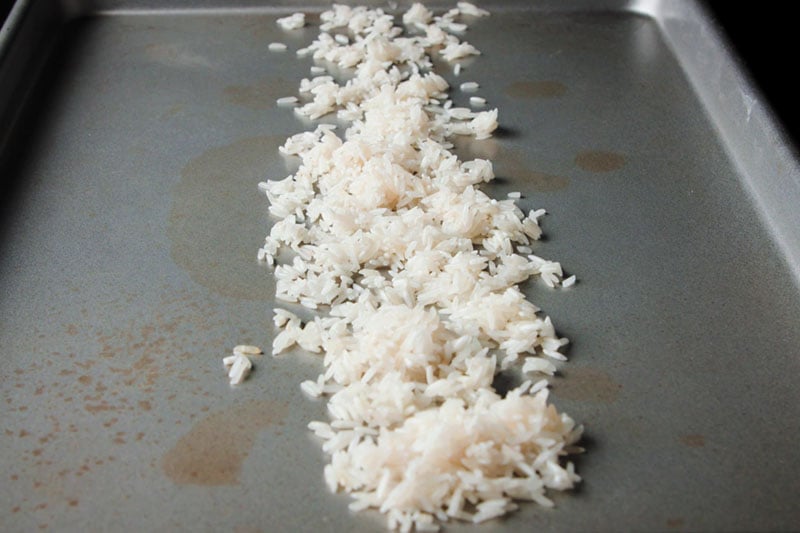
3. When the rice grains are thoroughly dried, add them to a dry grinder, blender or coffee grinder or a mixer-grinder.
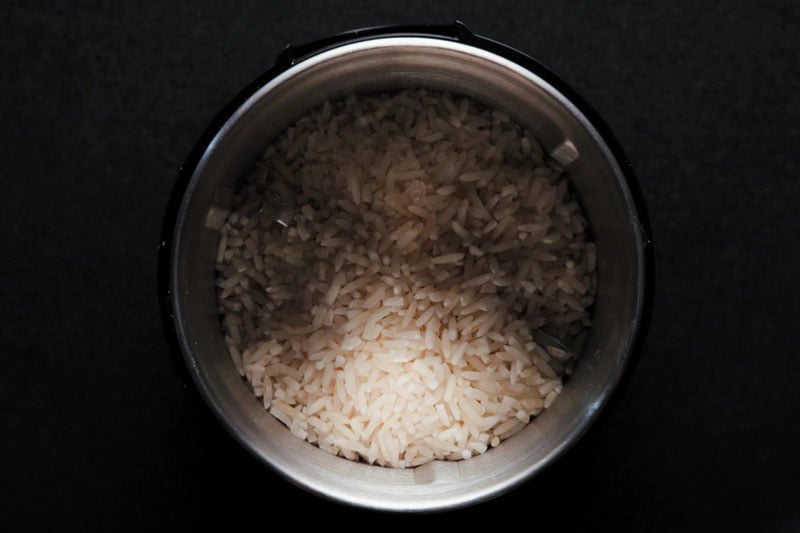
4. Grind until the consistency is coarse – resembling sooji (rava or fine semolina) or cornmeal or couscous. Set aside. Do not make a fine powder.
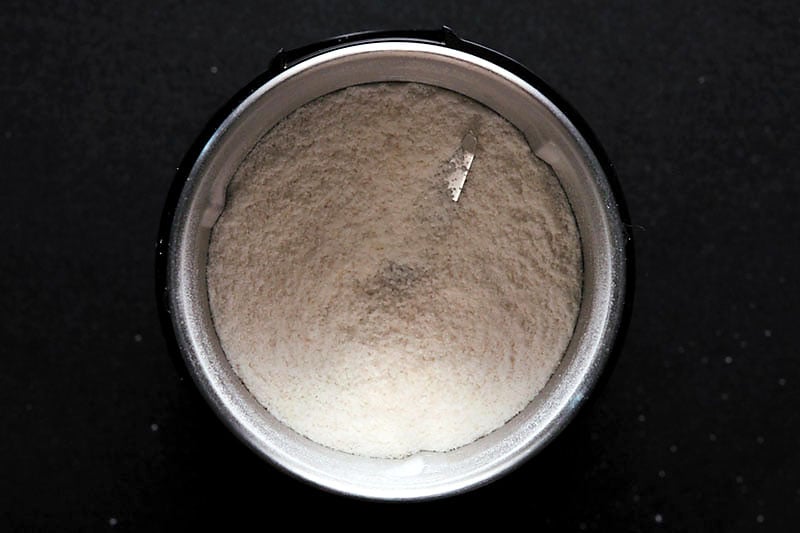
5. Heat 1 litre of whole milk in a saucepan or kadai till it begins to boil.
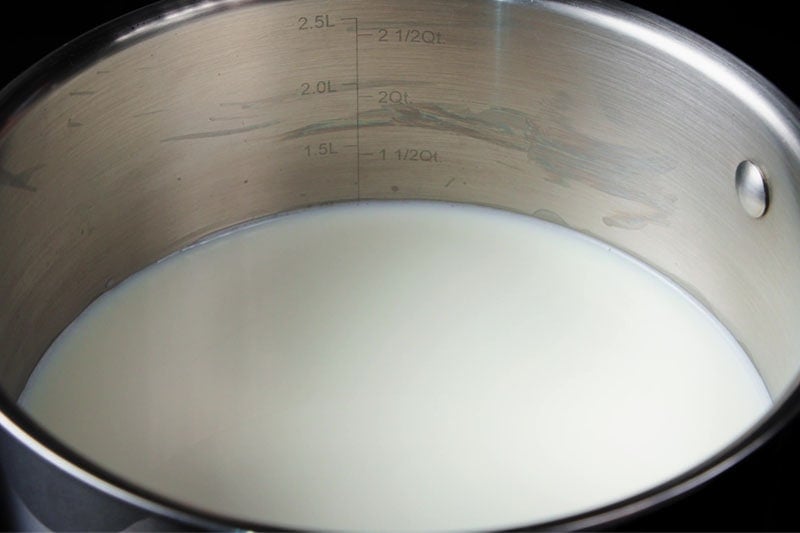
6. Whilst the milk is heating, take 1 tablespoon of warm milk in a small bowl and mix 12 to 15 saffron strands in it. Set aside.
Note that if you want to make kesar phirni having more flavors of saffron then increase the amount of kesar to about 25 to 30 saffron strands.
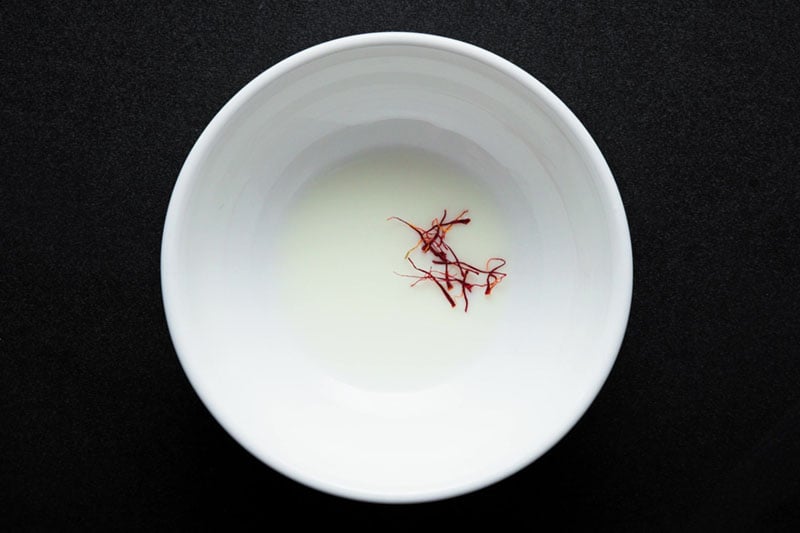
7. When the milk begins boiling, add the ground rice.
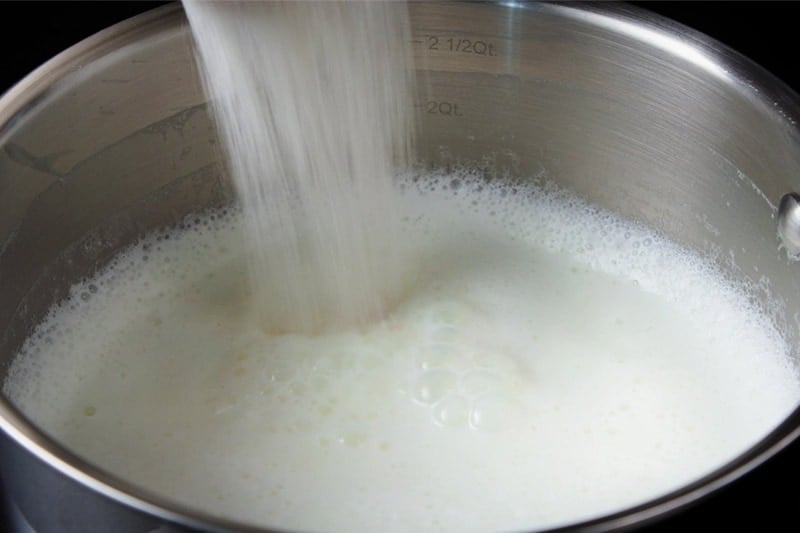
8. Mix and stir well.
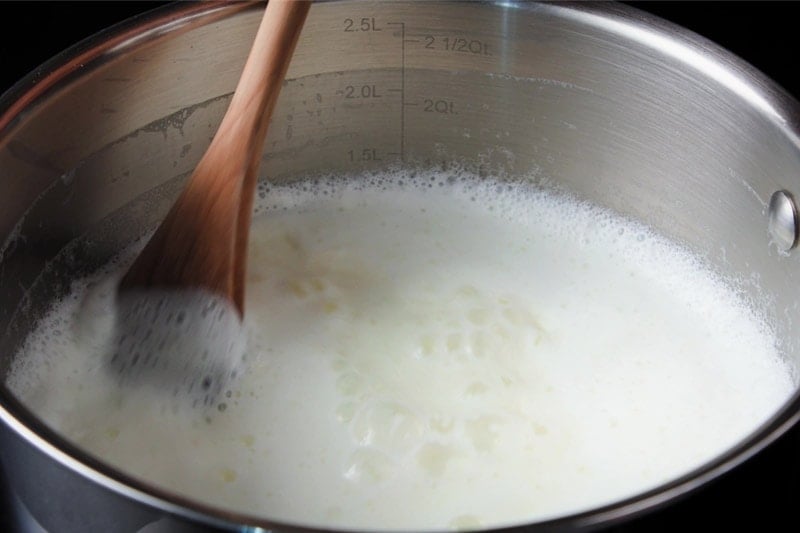
9. Next add ½ cup sugar or as required and stir again. For an extra sweeter phirni you can add about 2/3 to ¾ cup sugar.
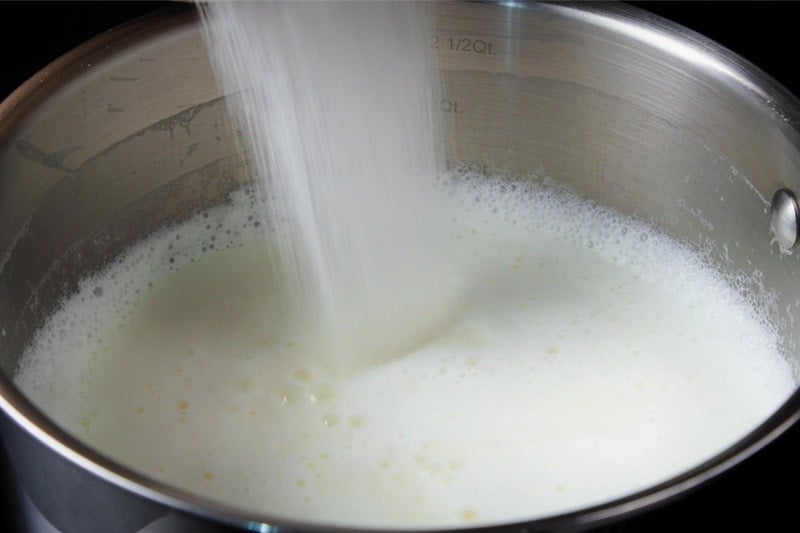
10. Cook the ground rice granules on low heat. Keep on stirring often so that lumps do not form. Also, scrape the sides often and add it to the simmering milk. The milk thickens gradually as the rice granules get cooked.
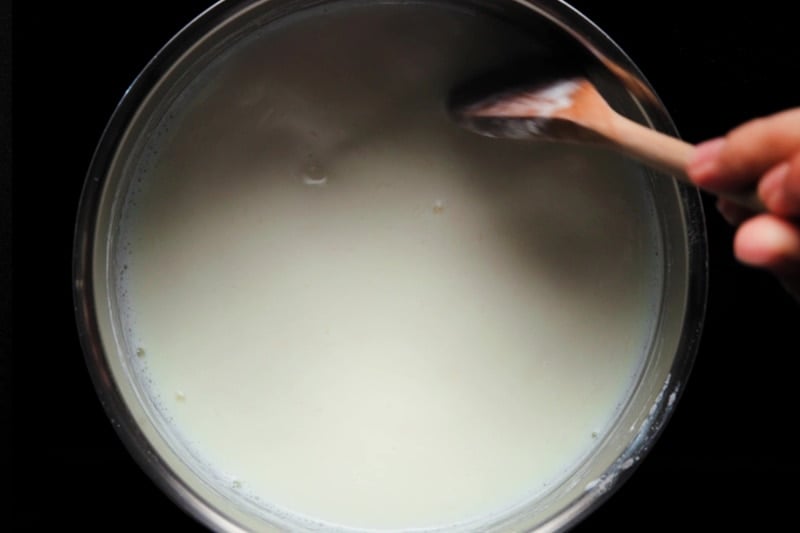
11. When the rice granules are almost cooked, add the cardamom powder (6 to 7 green cardamom crushed and powdered in mortar-pestle) and the saffron infused milk.
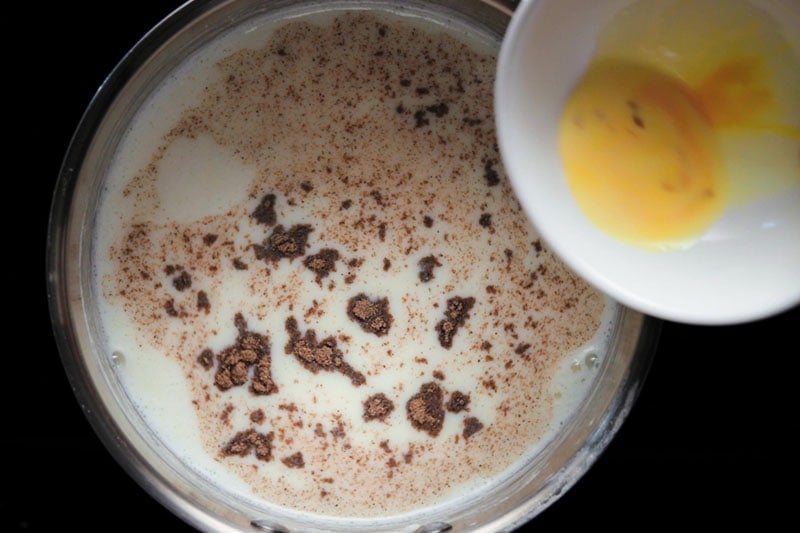
12. Add 10 to 12 blanched sliced almonds and blanched 10 to 12 pistachios (chopped or slivered).
For blanching the nuts, soak them in hot water for 30 minutes. Drain the water. Peel and remove the skins and chop or slice them.
You can also add chopped pinenuts or cashews.
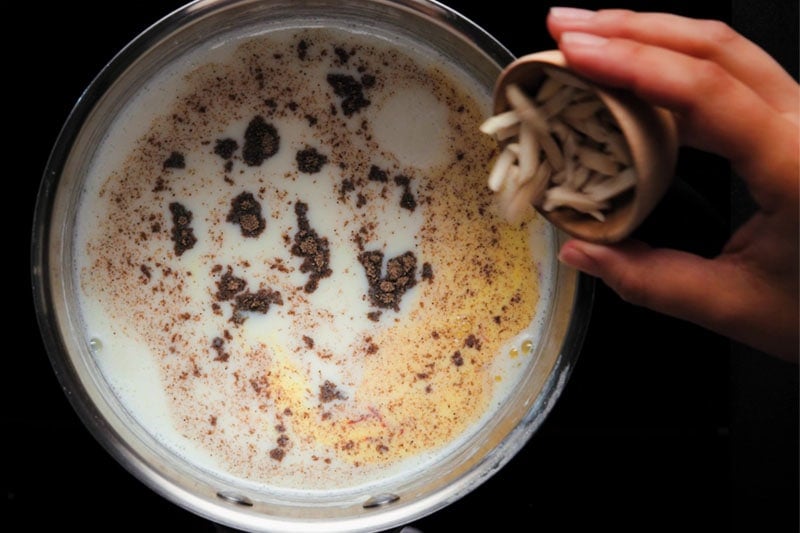
13. Cook firni for a further 5 to 6 minutes until the rice is completely softened or until you get a creamy pudding-like consistency. I cooked for about 25 minutes on low heat after I added the ground rice into the milk. Keep in mind that on cooling it will thicken more.
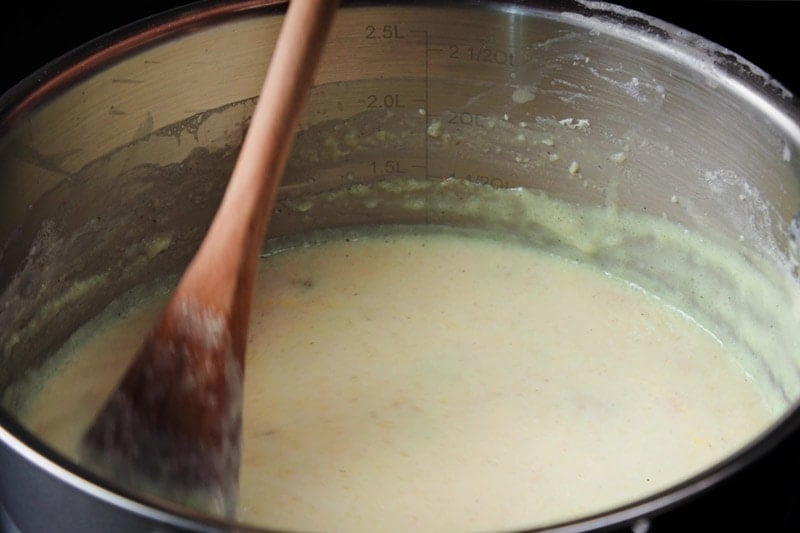
14. Lastly add 2 teaspoons of rose water. If you don’t have rose water then consider skipping it. Alternatively, add pandanus water (kewra water).
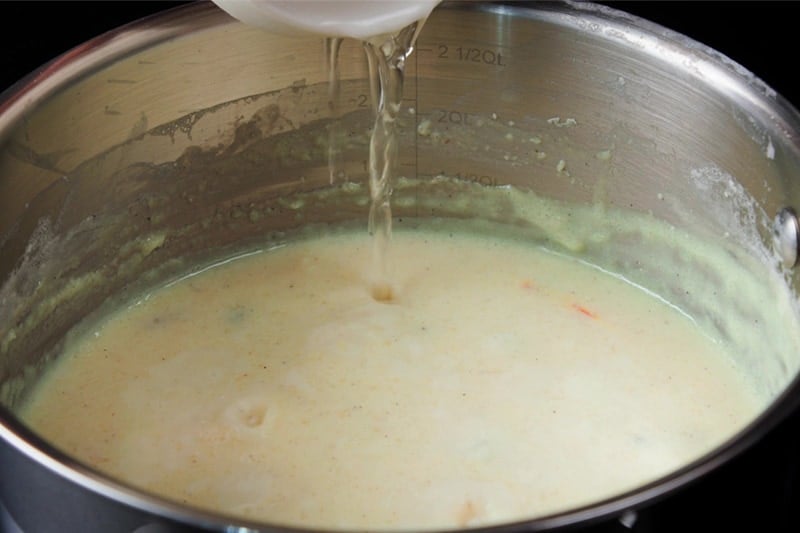
15. Pour firni in serving bowls. Sprinkle some of the blanched sliced almonds and blanched sliced pistachios on the top.
Note to make matka phirni, transfer the phirni in the small earthen bowls called as matka or shikora.
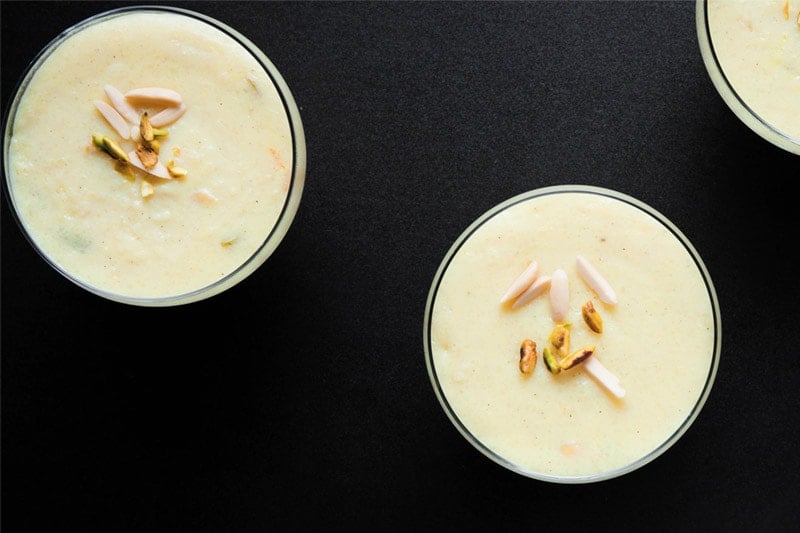
16. Cover the bowls tightly with lids or aluminum foil. When they become cool at room temperature, keep them in the fridge for about 4 hours or more.
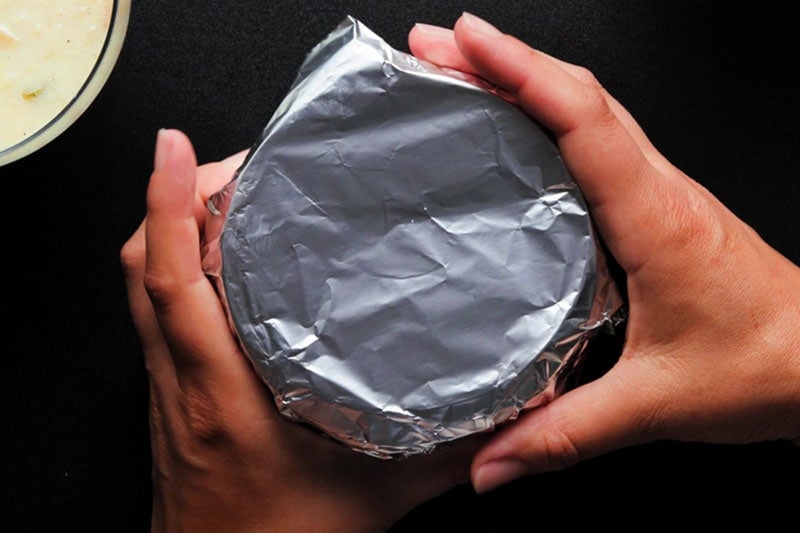
17. Phirni is always eaten cold. So you have to wait for some hours to enjoy this delicious sweet pudding. When it is set and chilled, garnish with some sliced almonds or pistachios or rose petals and serve.
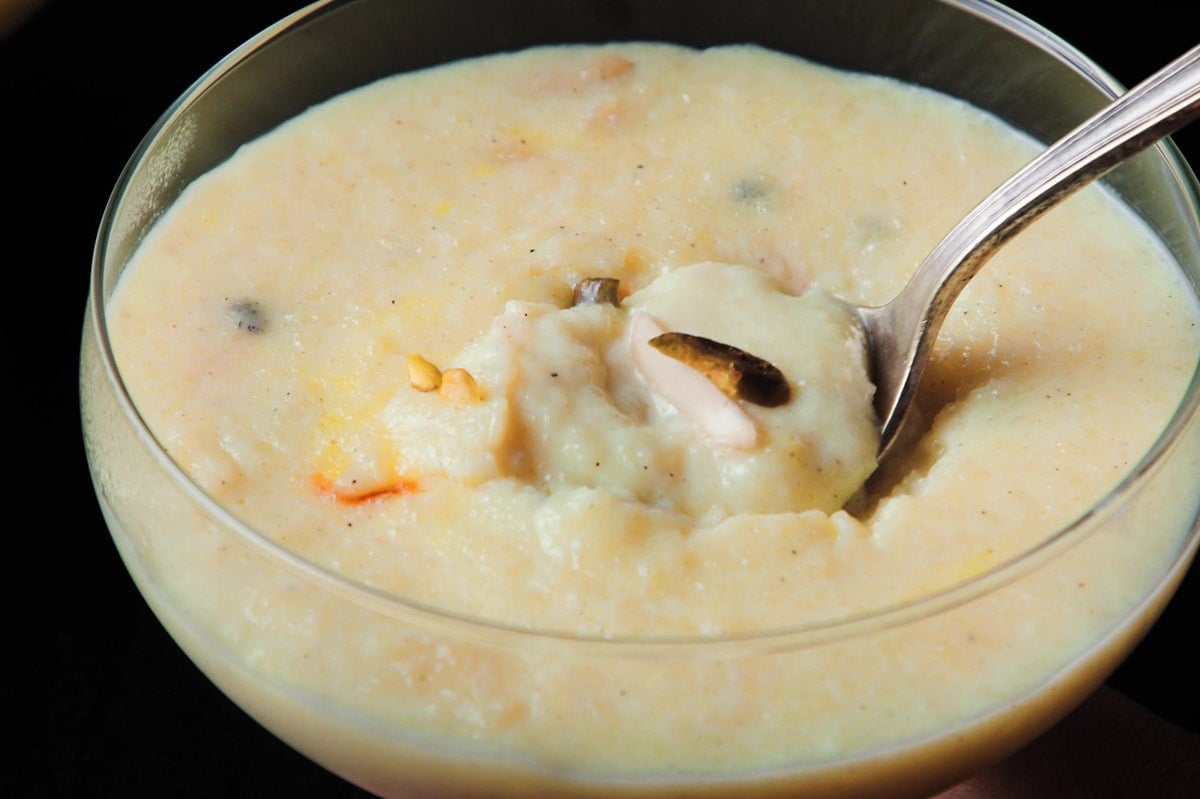
Variations to make Firni
- Fresh fruits: Pureed or grated fruits make a wonderful addition to your classic phirni. Add grated apples to make apple phirni. Add mango puree to make a delish Mango Phirni. Fruits like strawberries and lychee also make delicious variations. Another popular variation but not fruit based is kesar phirni which has more flavors of kesar a.k.a saffron.
- Sweeteners: For a rose scented phirni, add gulkand (rose petals preserve) instead of sugar. For a rustic version, replace sugar with jaggery or palm sugar. When the rice granules are softened and the phirni has been thickened – set it aside for 5 minutes. Then add jaggery or palm sugar.
FAQs
While fragrant basmati rice adds so much in terms of aroma in a phirni, you can easily replace it with any fragrant rice (non-sticky) or regular white rice.
Yes definitely. You can skip saffron but you will need to add some flavoring ingredients in the phirni recipe. Choose from cardamom powder or rose water or kewra water (pandanus water).
Yes you could do that. Once your phirni is cooked set it aside for 5 minutes. Then add chopped jaggery and mix thoroughly.
To make a vegan phirni recipe, you have to cook the ground rice in water first just like you would cook any other rice. Add sugar and mix until dissolved. Then add almond milk in parts, keeping on stirring until you get the thick creamy consistency.
For cooking ¼ cup rice, you can use 1.5 cups of water. Drain any water left in the rice grains when they are cooked and softened.
Phirni is always served cold.
In the refrigerator, phirni stays good for 2 to 3 days. In the freezer, for about a week.
More Classic Indian Sweets
Sweets Recipes
Sweets Recipes
Sweets Recipes
Sweets Recipes
If you’ve tried this recipe, please rate it in the recipe card or leave a comment below – I’d love to hear your feedback. For more vegetarian inspiration, sign up for my email updates or follow me on Instagram, Youtube, Facebook, Pinterest or X.
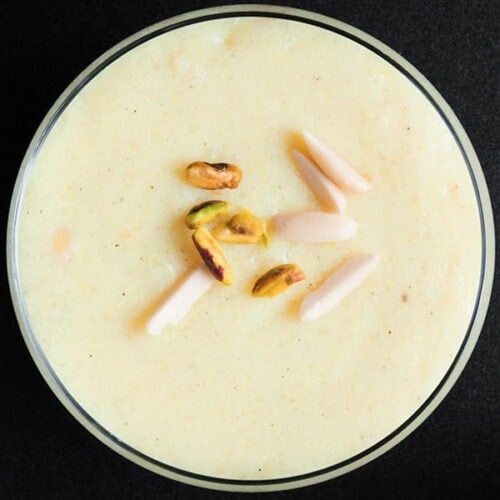
Phirni Recipe | Firni
Ingredients
- ¼ cup basmati rice
- 1 litre whole milk or organic milk
- ½ cup sugar or as required
- 10 to 12 almonds – blanched and peeled, reserve a few for garnishing
- 10 to 12 pistachios – blanched and peeled, reserve a few for garnishing
- ½ teaspoon cardamom powder or 6 to 7 green cardamoms, crushed and powdered in a mortar-pestle
- 12 to 15 saffron strands
- 2 teaspoon rose water or pandanus water (kewra water)
Instructions
Grinding rice
- Rinse the rice a couple of times in water. Drain the water and let them dry on their own by spreading them on a tray or plate. Or wipe the grains dry with a kitchen towel.
- Take the dried rice grains in a dry grinder or coffee grinder. Grind the rice till the consistency resembles sooji (rava or fine semolina) or corn meal or couscous .
- Alternatively, soak the rice in water for 30 minutes and then drain the water. Dry the rice grains naturally and later grind to a semi fine powder.
- Set the ground rice aside.
Blanching almonds and pistachios
- Take hot boiling water in a small bowl. Add the nuts and cover the bowl.
- Blanch for 30 minutes. Drain the water.
- When the almonds and pistachios become warm, then peel and later slice or chop them.
- Reserve a few almond and pistachio slices for garnish.
Making phirni
- Heat milk in a thick bottomed broad pan or sauce pan or kadai.
- When the milk becomes warm, take 1 tablespoon from it in a small bowl.
- Stir the saffron strands in this warm milk and keep aside.
- Let the milk reach to a boil. Then lower the heat and add the ground rice. Stir and add sugar also.
- On a low to medium heat cook the ground rice in the milk. Do not cover the pan.
- Keep on stirring at intervals so that the lumps are not formed.
- Also powder the cardamoms in a mortar-pestle. Discard the cardamom peels.
- When the rice is almost cooked, add the almonds, pistachios, cardamom powder and saffron infused milk.
- Stir and cook for a further 5 to 6 minutes or more or till the firni thickens and the rice granules are softened and cooked completely.
- Lastly add rose water, once the firni is done.
- Pour the phirni in serving bowls. Garnish it with the remaining chopped almond and pistachio slices.
- Cover the bowls tightly with lid or secure firmly with aluminium foil. Once cooled at room temperature, refrigerate phirni for about 4 hours or more.
- Serve phirni once cooled.
- Store it in the refrigerator for 2 to 3 days and in the freezer, for about 1 week.
Video
Notes
Ingredient Swaps:
- For basmati rice: Though fragrant basmati rice is the preferred rice in this recipe, but you can easily replace it with any fragrant rice (non-sticky) or a regular rice.
- For saffron: Skip saffron but do add some aromatic ingredient in its place. Choose from cardamom powder or rose water or kewra water (screw pine water). If you want to make kesar phirni having more flavors of saffron then increase the amount of kesar to about 25 to 30 saffron strands.
- For sugar: Use jaggery or palm sugar or coconut sugar. Once the phirni is cooked, remove it from the heat and set it aside for 5 minutes. Then add chopped jaggery or or palm sugar or coconut sugar and mix thoroughly.
- Vegan version: Cook the ground rice in water just like you would cook any other rice. Add sugar and mix until dissolved. Then add almond milk in parts, keeping on stirring until you get the thick creamy consistency. For cooking ¼ cup rice, you can add 1.5 cups water. Drain any water left in the rice grains when they are cooked and softened.
Blanching almonds in a microwave:
- In a microwave safe bowl take the almonds and water.
- The water should cover the almonds enough.
- Microwave the almonds for 2-3 minutes.
- Once warm or cool then peel the almonds and slice them.
Nutrition Info (Approximate Values)
Phirni Recipe from the archives was first published on October 2013.
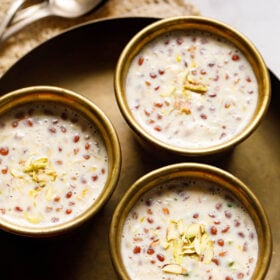
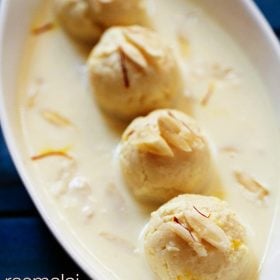
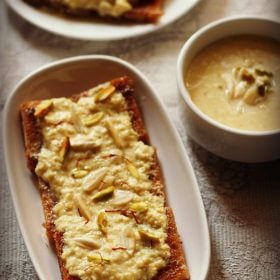
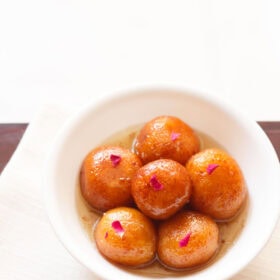
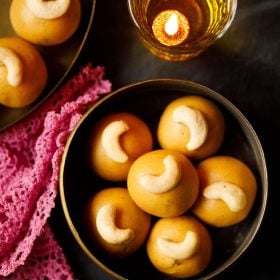
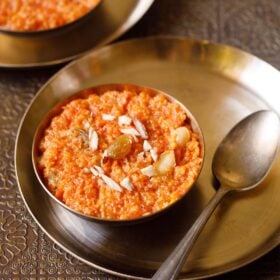
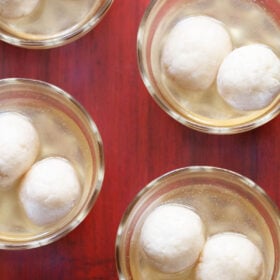
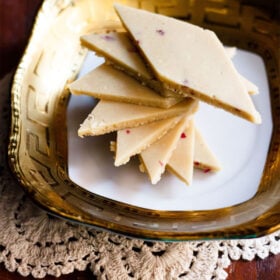








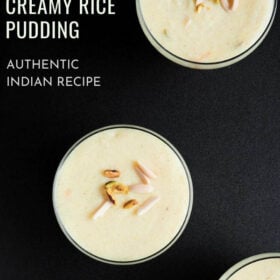
Can we use rice flour instead of soaked rice grains?
Thanks.
If the rice flour has a coarse texture or is coarsely ground, you can use it.
Why we add more sugar in phirni than kheer???
Any sweet dish that is served cold needs to have more sugar as on cooling the sweet taste gets reduced and not felt much. It also depends on the recipe and the proportion of rice and milk used.
Anything that’s served cold needs more sugar , just an observation
Hello,
thank your for this great recipe (and the whole Blog!).
As I needed to use coconut milk, I used 500ml of this + 500ml of selfmade cashewmilk.
It turned out great and reminded me of a trip to Amritsar!
thank a lot. thanks for sharing the variations you made. happy cooking.
Very nicely explained and the firni turned out to be super delicious. Thanks a ton for sharing it☺️☺️
I always wanted to make phirni, tried once but failed. But today I came across your receipe and you explained it so well that I decided to do it right away. I followed every step and it turned out so delicious . My son tasted it and said thumbs up mum. I am so happy and confident now that I can prepare this wonderful and tasty sweet whenever I have a party. Thank u Dassana soooo much for sharing. I like your blog and I shall try your awesome .receipes
thats great and thanks for sharing this olive. glad to know. do try the other recipes as well. happy cooking.
Lovely recipe. I had made this today for dessert and all my guests loved it. I added sugar couple of teaspoons less than ¾ cup for the same amount of milk and rice and the taste was perfect for all of us. Thanks a lot for the recipe. You rock!
thanks anuradha for sharing this feedback. good to know that your guests liked the phirni recipe. happy cooking.
Easy recepies
Sam can You show a Vegan Version of this recipe
Heena, for a vegan version use almond milk. You will have to cook the rice in water. Once the rice is cooked add sugar first. Mix very well and let it dissolve. Then add almond milk. Keep on stirring till the almond milk becomes warm. Do not heat almond milk. Just let it get become warm. For cooking ¼ cup of rice, you can use 1.5 cups of water. If there is some water left behind after the rice is cooked, then drain all the water. 2 to 3 cups of almond milk can be used in this recipe. It will depend on how much thick you want the phirni to be.
Can we make Phirni without saffron
yes you can skip saffron.
can i substitute sugar with jaggery?
yes, you can. but add jaggery in the last once the phirni has thickened, as jaggery can curdle milk.
Mam can I use anything else for basmati rice…the price hike is really getting to me..lol
🙂 veena, you can use any regular rice.
This is the sweet dish that has been the traditional treat dish among North Indian Muslims.
Hello mam,
Can I make this phirni recipe as a bhog for laxmi mata……
suvidha, yes you can make the phirni recipe as a bhog for maa laxmi.
Thanku mam…..
welcome suvidha.